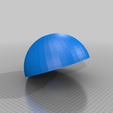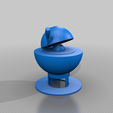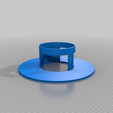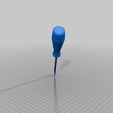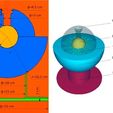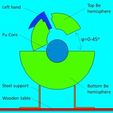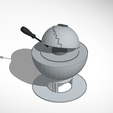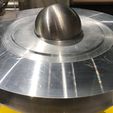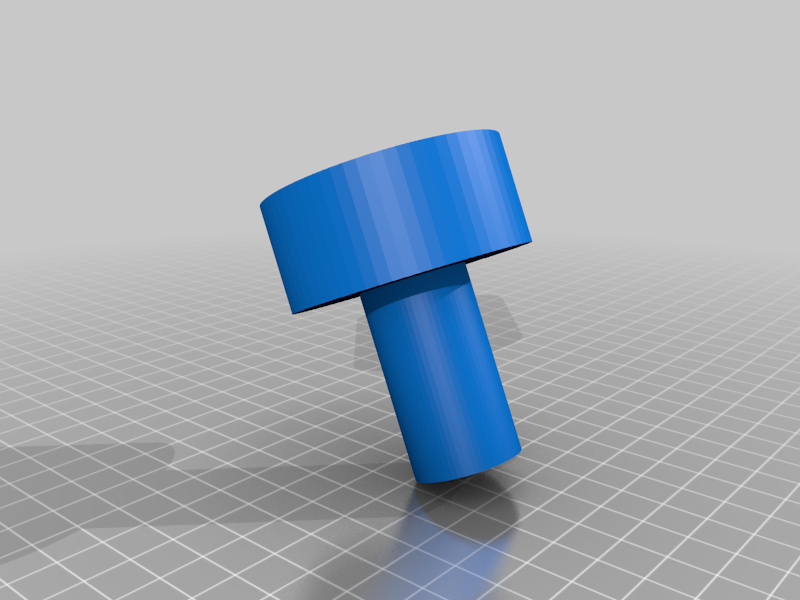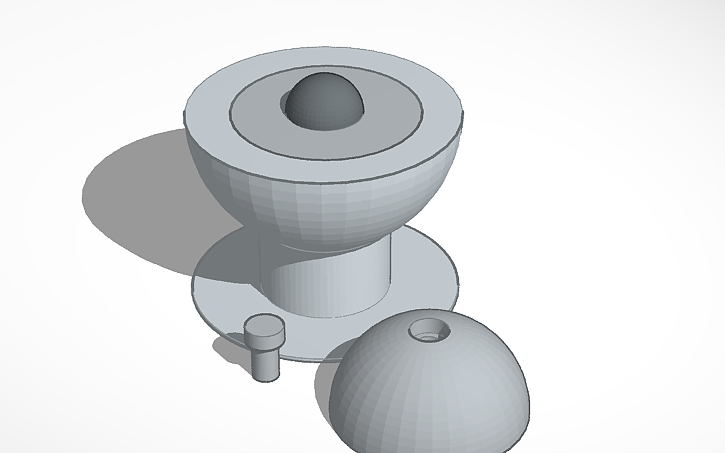Demon Core Mockup.
Scale 1:1.
By Szadros.
THE DEMON CORE.
The Demon Core was a spherical 6.2-kilogram (14 lb) subcritical mass of plutonium 89 millimetres (3.5 in) in diameter, manufactured during World War II by the United States nuclear weapon development effort, the Manhattan Project, as a fissile core for an early atomic bomb.
The demonstration began on the afternoon of May 21, 1946, at a secret laboratory tucked into a canyon some three miles from Los Alamos, New Mexico, the birthplace of the atom bomb. Louis Slotin, a Canadian physicist, was showing his colleagues how to bring the exposed core of a nuclear weapon nearly to the point of criticality, a tricky operation known as “tickling the dragon’s tail.” The core, sitting by itself on a squat table, looked unremarkable—a hemisphere of dull metal with a nub of plutonium sticking out of its center, the whole thing warm to the touch because of its radioactivity. It had been quickly molded into shape after the bombing of Nagasaki, to be used in another attack on Japan, then reallocated when it turned out not to be needed for the war effort. At that time, Slotin was perhaps the world’s foremost expert on handling dangerous quantities of plutonium. He had helped assemble the first atomic weapon, barely a year earlier, and a contemporary photograph shows him standing beside its innards with his shirt unbuttoned and sunglasses on, cool and collected. Back then, the bomb was a handmade, artisanal product.
Slotin’s procedure was simple. He would lower a half-shell of beryllium, called the tamper, over the core, stopping just before it was snugly seated. The tamper would reflect back the neutrons that were shooting off the plutonium, jump-starting a weak and short-lived nuclear chain reaction, on which the physicists could then gather data. Slotin held the tamper in his left hand. In his right hand, he held a long screwdriver, which he planned to wedge between the two components, keeping them apart. As he began the slow and painstaking process of lowering the tamper, one of his colleagues, Raemer Schreiber, turned away to focus on other work, expecting that the experiment would be uninteresting until several more moments had passed. But suddenly he heard a sound behind him: Slotin’s screwdriver had slipped, and the tamper had dropped fully over the core. When Schreiber turned around, he saw a flash of blue light and felt a wave of heat on his face. A week later, he wrote a report on the mishap:
The blue flash was clearly visible in the room although it (the room) was well illuminated from the windows and possibly the overhead lights. . . . The total duration of the flash could not have been more than a few tenths of a second. Slotin reacted very quickly in flipping the tamper piece off. The time was about 3:00 p.m.
A guard who was stationed in the room to keep an eye on the precious plutonium had little knowledge of what Slotin was doing. But when the core started to glow and people started yelling, he promptly ran out the door and up a nearby hill. Subsequent calculations put the total number of fission reactions at about three quadrillion—a million times smaller than the first atomic bombs, but still enough to send out a significant burst of radioactivity. This radioactivity excited the electrons in the air, which, as they slipped back into an unexcited state, emitted high-energy photons—the blue flash.
An ambulance was called, and the lab was mostly evacuated. As the scientists waited for help to arrive, they tried to work out how much radiation they had received. Slotin made a sketch of where everyone had been standing when the slip occurred. He then tried to use a radiation detector on various items that were near the core—a bristle brush, an empty Coca-Cola bottle, a hammer, a measuring tape. But it proved difficult to get an accurate reading, because the detector itself had been heavily contaminated. Slotin instructed one of his colleagues to lay radioactivity-detecting film badges around the area, which required the scientist to go dangerously close to the still overheated core. The errand resulted in no useful data, and was mentioned in a later report as evidence that, after an exposure of this magnitude, human beings “are in no condition for rational behavior.”
The witnesses to the demonstration were taken to the Los Alamos hospital. Slotin vomited once prior to being examined, and several times more in the next few hours, but stopped by the next morning. His general health seemed acceptable. But his left hand, initially numb and tingling, became increasingly painful. This was the hand that had been closest to the core, and scientists later estimated that it had received more than fifteen thousand rem of low-energy X rays. Slotin’s whole-body dose was around twenty-one hundred rem of neutrons, gamma rays, and X rays. (Five hundred rem is usually fatal for humans.) The hand eventually took on a waxy blue appearance and developed large blisters. Slotin’s physicians kept it packed in ice, to limit the swelling and the pain. His right hand, which had been holding the screwdriver, suffered lesser versions of these symptoms.
Slotin called his parents, in Winnipeg, who were flown out to New Mexico on the Army’s dime. They arrived four days after the accident. On the fifth day, Slotin’s white-blood-cell count dropped dramatically. His temperature and pulse began to fluctuate. “From this day on, the patient failed rapidly,” the medical report noted. Slotin suffered nausea and abdominal pain and began losing weight. He had internal radiation burns—what one medical expert called a “three-dimensional sunburn.” By the seventh day, he was experiencing periods of “mental confusion.” His lips turned blue and he was put in an oxygen tent. Eventually, he sank into a coma. He died nine days after the accident, at the age of thirty-five. The cause was recorded as acute radiation syndrome, also known as radiation sickness. His body was shipped to Winnipeg for burial in a sealed Army casket.
Slotin was one of only two people to die from radiation exposure at Los Alamos while the laboratory was under military control. In those early years, from 1943 to 1946, there were about two dozen other deaths—truck and tractor accidents, inadvertent weapons discharges, a suicide, a drowning, a fall from a horse. Four of the fatalities were just bad luck, involving a group of janitors who shared muscatel wine that was laced with antifreeze. But only Slotin and his co-worker Harry Daghlian, Jr., succumbed to the special hazards of the Manhattan Project. Nine months to the day before Slotin’s accident, Daghlian had been working with the very same plutonium core, performing a different criticality experiment that used tungsten-carbide blocks instead of the beryllium tamper.* He dropped one of the blocks, and the core briefly went critical. Daghlian took nearly a month to die.
After Slotin’s botched demonstration, Los Alamos halted all further criticality work. It was always known to be dangerous—Enrico Fermi himself had warned Slotin that he would be “dead within a year” if he continued—but the exigencies of the Second World War had privileged expediency over safety. Handcrafted critical masses could be modified quickly and on the fly. But by the time Slotin died such speed was no longer necessary. The Cold War, in spite of its many anxieties, could be taken at a more steady pace. A memo written soon after the accident suggested that future experiments should use remote controls and make “more liberal use of the inverse-square law”—the fact that a little bit of distance goes a long way in decreasing radiation exposure.
The plutonium pit that killed Daghlian and Slotin was originally nicknamed Rufus, but after the accidents it came to be called the demon core. The pits that killed tens of thousands in Hiroshima and Nagasaki, meanwhile, got no such pejorative monikers. Such is the difference, perhaps, between intended and unintended harm, between the core carefully assembled for the purpose of mass destruction and the core reserved for the realm of experiment.
Prior to the accident, officials at Los Alamos expected to send the core to Bikini Atoll, in the Marshall Islands, where it would be detonated in front of thousands of observers as part of Operation Crossroads, the first postwar series of nuclear tests. (Slotin planned to go to Bikini, too, and then take up a teaching position at the University of Chicago when the test series was finished.) After the accident, though, the core was still radioactive enough that it needed time to cool off. It was slated for use in the third test at Crossroads, but the test was cancelled. Records from Los Alamos indicate that the core ultimately met with an anticlimactic fate: in the summer of 1946, it was melted down and recast into a new weapon.
By Alex Wellerstein, a historian of science and an assistant professor at the Stevens Institute of Technology, in New Jersey.
Attributions:
•Screwdriver by user DAPE, Cults3D (under CC-By-Sa-Nc).
•Demon Core modeled by Szadros.

/https://fbi.cults3d.com/uploaders/14042810/illustration-file/f4747955-502c-4be9-8849-0e037d8039ba/Demon_Core_Top_Be_Hemisphere.png)
